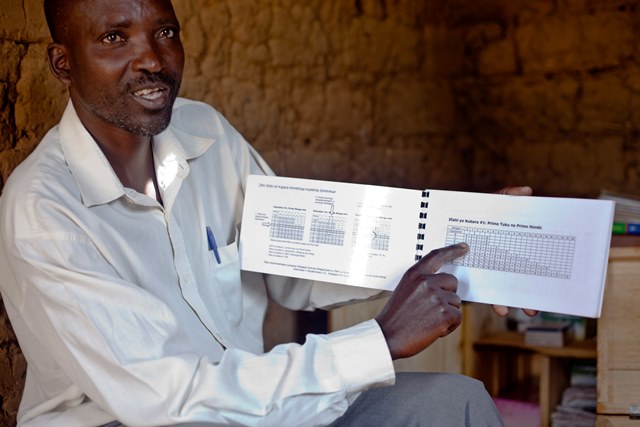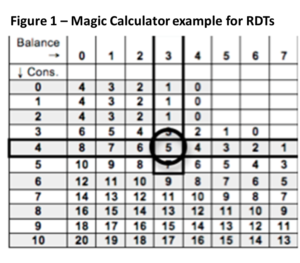The SC4CCM Project developed a standardized monthly resupply system that requires simple documentation and procedures. The project used historical consumption data to determine appropriate stock levels for each product for community health workers (CHWs). There are three main tools – stock cards maintained by the CHWs, a resupply worksheet maintained by the Cell Coordinators (CCs) and a “magic calculator”. The simple “magic calculator” (fiche de calcul in French) determines the resupply quantities for each product needed by each CHW based on actual data and standard calculations, obviating the need for manual calculations and reducing the potential for error.

A cell coordinator shows how to use the magic calculator
The resupply calculator is meant to be an easy way for CCs to determine resupply quantities for the CHWs in their cell, based on quantities dispensed to patients over the past month and their current stock on hand (SOH). It is currently designed for the following products dispensed at the community level in Rwanda: ORS sachets, zinc 10mg tablets, amoxicillin 125mg tablets, Primo Rouge, Primo Jaune, RDTs, and gloves. Consumption patterns of CHWs were analyzed to establish inventory management parameters. These were reviewed and revised in April 2013 and this process should be repeated regularly to ensure resupply quantities are in line with demand trends.
Currently calculators are available for the 7 products dispensed by binomes, though products with similar consumption patterns use the same calculator:
- One calculator for Primo Rouge and Primo Jaune
- One calculator for Amoxicillin 125mg tablets and Zinc 10mg tablets
- One calculator for ORS and for gloves
- One calculator for RDTs for testing for malaria
The calculator is based on the idea that each CHW should have twice the quantity that they used the past month, or roughly a two month stock on hand, to ensure adequate buffer if trends change. The formula for this is:
Resupply quantity = (dispensed-to-user x 2) – Stock on Hand
Each product has a specific minimum quantity that each CHW should have to ensure sufficient buffer stock, even if their consumption in the past month was zero. This ensures that a CHW is able to treat any child that comes to see them.
| Product | Minimum quantity | Treatments |
| Primo Rouge and Primo Jaune | 2 packs of each | Treatment for two children in each age group |
| Amoxicillin 125mg tablets | 80 tablets | Enough to treat two children of the highest age/weight group |
| RDTs | 4 tests | Enough to conduct four malaria tests |
| Zinc 10mg tablets | 80 tablets | Enough to treat four children of the highest age/weight group |
| ORS | 20 sachets | Enough to treat 5 children |
| Gloves | 20 gloves | Enough for 10 uses |
 For an example of how the magic calculator works, use Figure 1 and the following instructions:
For an example of how the magic calculator works, use Figure 1 and the following instructions:
- If you are looking at a CHW’s stock card and his/her past month’s consumption of RDTs was 4 tests, find this number in the left column labeled “Cons.”
- The same stock card shows that the CHW currently has 3 tests in stock. Find this amount (the current stock on hand) across the top row labeled “Balance.”
- Find where the consumption and balance meet. The quantity in the point of intersection is 5. This is the resupply quantity for the CHW this month. Because the CHW’s monthly consumption was 4 tests and we want to ensure he/she has two month’s stock on hand, based on the past month’s consumption level, the CHW needs to have 8 tests. The CHW already has 3 tests, so he/she requires 5 additional RDTs to be adequately stocked.
The magic calculator works well for Rwanda because of low consumption of each product each month per CHW; if the quantities were very high there would be many rows and columns which would make the tool much more cumbersome.
See the full version of the magic calculator.
Download this overview of the magic calculator.

